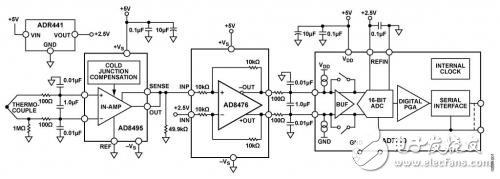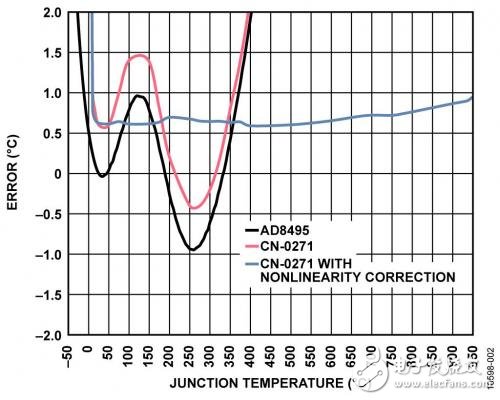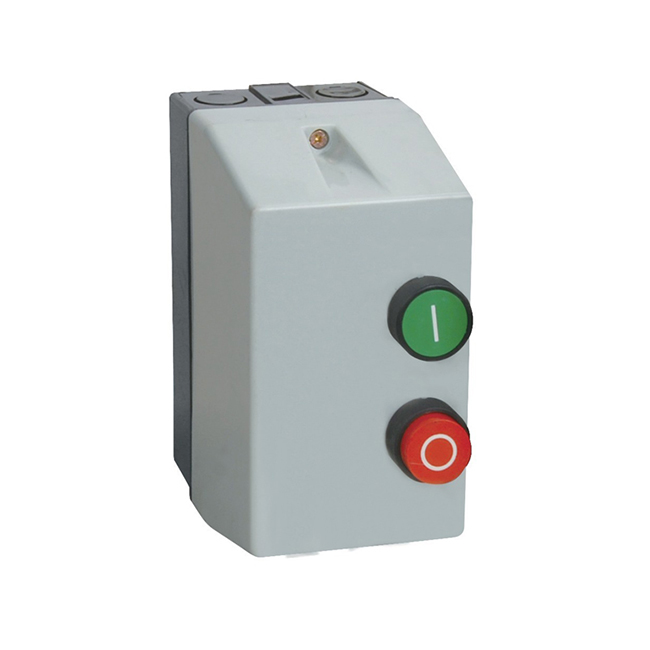Circuit function and advantage
The circuit shown in Figure 1 is a complete thermocouple signal conditioning circuit with cold junction compensation followed by a 16-bit ∑-Δ analog-to-digital converter (ADC). The AD8495 thermocouple amplifier provides a simple, low-cost solution for measuring K-type thermocouple temperatures and includes cold junction compensation.
The fixed gain instrumentation amplifier in the AD8495 amplifies the small voltage of the thermocouple to provide a 5 mV/°C output. The amplifier has high common-mode rejection and is capable of rejecting common-mode noise that may be picked up by long leads of thermocouples. For extra protection, the amplifier's high-impedance input allows for easy additional filtering.
The AD8476 differential amplifier provides the correct signal level and common-mode voltage to drive the AD7790 16-bit Σ-Δ ADC.
This circuit provides a compact, low-cost solution for thermocouple signal conditioning and high resolution analog to digital conversion.

Figure 1. K-type thermocouple measurement system with integrated cold junction compensation (schematic diagram: all connections are not shown)
Circuit description
Thermocouples are a simple component that is widely used for temperature measurement. It consists of a junction of two heterogeneous metals. These metals are connected at one end to form a measurement junction, also known as a hot junction. The other end of the thermocouple is connected to a metal wire connected to the measuring electronics. This connection forms the second junction, the reference junction, also known as the cold junction. In order to derive the temperature of the junction (TMJ), the user must know the differential voltage generated by the thermocouple. The user must also know the error voltage generated by the reference junction temperature (TRJ). The compensation reference junction temperature error voltage is called cold junction compensation. In order for the output voltage to accurately represent the thermal junction measurement, the electronics must compensate for any changes in the reference (cold) junction temperature.
The circuit uses an AD8495 thermocouple amplifier and is powered from a single 5 V supply. The output voltage of the AD8495 is calibrated for 5 mV/°C. With a single 5 V supply, the output remains linear between approximately 75 mV and 4.75 V, corresponding to a temperature range of 15 °C to 950 °C. The output of the AD8495 drives the non-inverting input of the AD8476 unity-gain differential amplifier, which converts the single-ended input to a differential output that drives the AD7790 16-bit Σ-Δ ADC.
The low-pass differential and common-mode filters in front of the AD8495 input eliminate the RF signal, and if left to the AD8495, it may be rectified, exhibiting temperature fluctuations. Two 100Ω resistors and a 1μF capacitor form a differential filter with a cutoff frequency of 800Hz. Two 0.01nF capacitors form a common mode filter with a cutoff frequency of 160 kHz. The output of the AD8476 differential amplifier uses a similar filter before the signal is applied to the AD7790 ADC.
The AD8495 input protects the device from input voltage offsets up to 25 V from the opposite supply rail. For example, in this circuit, the device can safely withstand an input voltage of -20 V to +25 V when the positive supply rail is 5 V and the negative supply rail is grounded. The voltage at the reference and sense pins must not exceed 0.3 V above the supply rail. This feature is especially important for applications where power sequencing issues are present, which can cause the source to be active before the amplifier power is applied.
The theoretical resolution of the system can be calculated from the bandwidth, voltage noise density, and gain of the AD8495. The peak-to-peak (no noise code) resolution (in bits) is:


The AD8476 is a very low power, fully differential precision amplifier that integrates a thin film laser trimmed 10kΩ gain resistor for unity gain. It is ideal for this type of application because it prevents a relatively high impedance load from being applied to the AD8495.
The AD7790 is a low power, complete analog front end for low frequency measurement applications with a low noise 16-bit sigma-delta ADC with a differential input that can be configured in either buffered or unbuffered mode.
Test Results
An important measure of the performance of this circuit is the amount of linear error. The output accuracy of the AD8495 is within 2 °C from -25 °C to +400 °C. To achieve higher accuracy when working inside or outside of this range, a linear correction algorithm must be implemented in the software. The CN-0271 evaluation software uses a NIST thermoelectric voltage look-up table to ensure that the output error is within 1 °C from 15 °C to 950 °C.
Figure 2 compares the performance of the AD8495 with the CN-0271 system and shows the results of linearization corrections to the ADC output. For details on how to implement this algorithm in software, see Thermocouple Linearization when using the AD8494/AD8495/AD8496/AD8497 in the AN-1087 Application Note.

Figure 2. AD8495 output error, CN-0271 circuit total error Figure 2. AD8495 output error,
Total error of CN-0271 circuit and total error of CN-0271 circuit after thermocouple nonlinear correction
Magnetic Starter is mainly applied to circuit of AC 50 or 60Hz,voltage up to 550V for far distance making and breaking circuit and frequent start and control motor. It has the features of small volume, light, weight, low power consumption, high efficiency, safe and reliable perfomance etc.
The types of Magnetic Starters are as following:
LC1-D Magnetic Starter
NEW Type Magnetic Starter
BLS-MB Magnetic Starter
Star-Delta Starter

Magnetic Starters
Magnetic Starter,Magnetic Motor Starter,3 Phase Motor Starter,3 Phase Magnetic Starter
Ningbo Bond Industrial Electric Co., Ltd. , https://www.bondelectro.com